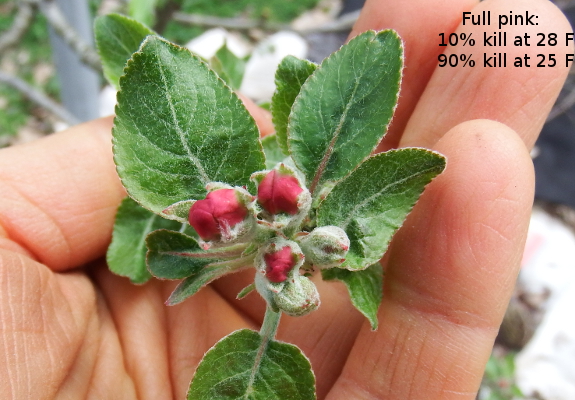
archives for 04/2016
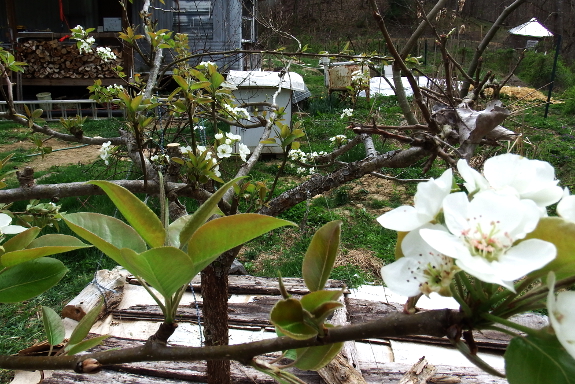
It feels odd to wait so
long to prune, until the pears are blooming and the apple buds are
showing their first signs of pink. But the late approach actually makes
the work easier since you can see exactly what each twig is going to do.
You just have to be careful not to knock off tender flower buds while
you work.
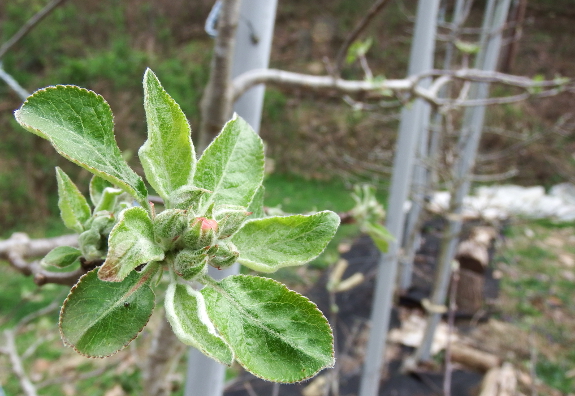
Our fruit trees came
through the winter unscathed this year, partly because we ripped out the
tender peaches last spring and partly because this past winter just
wasn't as harsh. The real test of fruiting, of course, will come during
Dogwood and Blackberry Winters, when lows may drop beneath the flowers' critical temperatures. I've resolved to cover what I can, but it's hard to imagine protecting whole trees!
We used old
pallets for our first woodshed floor and they did not last long.
The new floor is made from
treated 2x4's secured to each side wall.
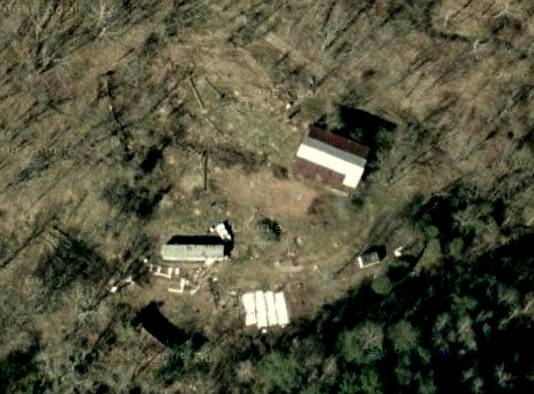
I was geekily excited
this week to discover that Google updated their satellite photos of our
area. Now I have a third aerial photo to add to our string of farm baby
pics! The oldest one, above, dates from soon after we moved in.
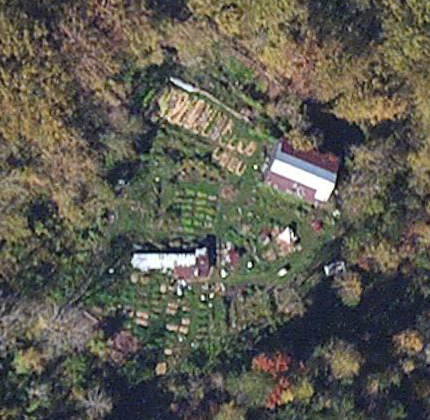
This one is from fall 2011 (courtesy of Bing).
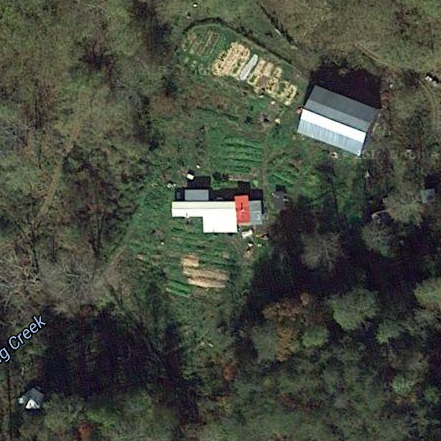
And here's our current
one that I would date to fall 2015. You can see that we're slowly
streamlining our front garden (near the bottom of the photo above) and
had recently planted garlic in those non-patchwork beds.
Thanks for the gift of perspective, Google!
We had a minor goat break out
this morning.
No real damage....Abigail is
pretty good at finding our weak spots in the fence.
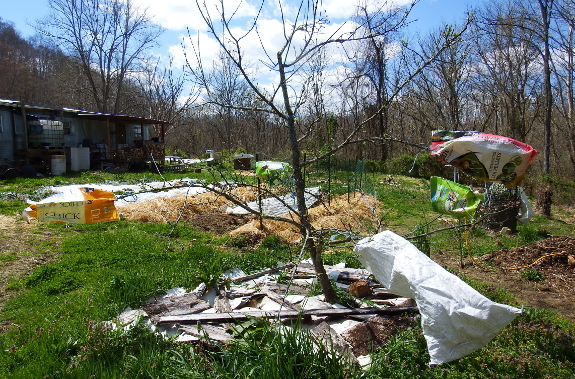
Spring freezes always
make me wish I could just send up a dome to enclose our entire core
homestead. Since Mark hasn't yet invented such a device, I'm stuck
choosing which plants to protect with the materials we have on hand.
This year, we're trying something new to me but that my mother has used to good result in years past
--- plastic dog-food bags. (Yes, some of my bags started with chicken
feed or cover-crop seeds inside them, but you know what I'm talking
about.)
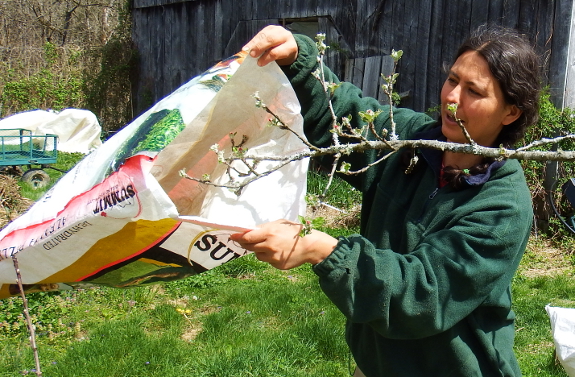
The bags are a little
tricky to pull over tree limbs without knocking flower buds off, and I
opted to tie each one partway closed in hopes the wind won't catch
inside and yank yet more plant parts free. But I have high hopes that
the still-air pocket created will protect blooms from the upcoming
freezes and that the bag will still be breathable enough that it will be
okay to leave them on for the solid week of cold we've got ahead.
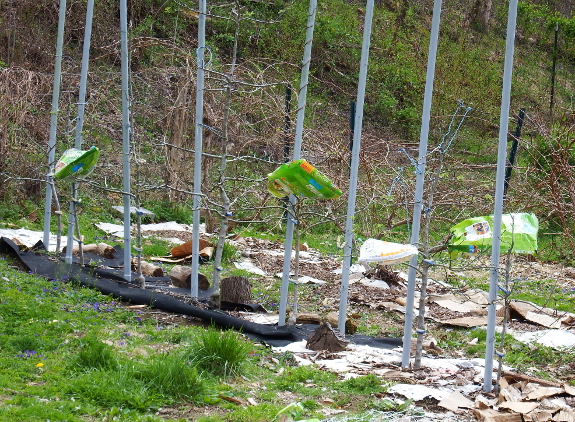
As you can see, I only
covered a small subset of my apple limbs. Partly that's because I ran
out of bags and partly that's because I want a control just in case the
bags make matters worse rather than better. Stay tuned for results....in
June.
The first half of April is a good time to start sweet potatoes in some wet sand.
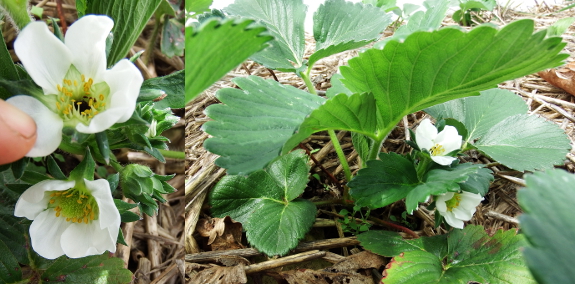
After frost-protecting apple branches,
my eye next turned to the smaller garden plants. Despite recent warmth
tempting me to set out tender seedlings, most of the garden is still
pretty cold hardy. Lettuce, kale, peas, arugula --- all will likely
coast along just fine on the soil's residual heat. Broccoli and onions
have been under row covers since I set them out just in case. But what
about the strawberries?
Most of our plants have their bloom buds only barely visible, but plants of the ultra-early variety I pushed ahead with a quick hoop
are starting to bloom. And a blackened center of one flower proves that
the quick hoop alone wasn't enough to protect that bloom from even our
recent semi-mild freezes.
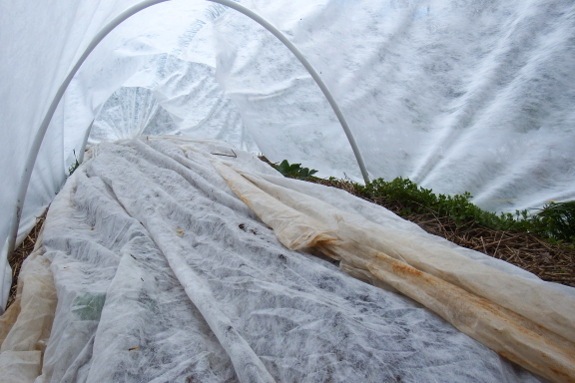
So how about an extra row cover under that quick hoop?
The real trick here will
be remembering to disinter the plants during warm spells within our cold
week. After all, flowers won't turn into fruits if they're not
pollinated.
We replaced our troubled back
steps with treated step stringers and 2x10 planks.
Total cost was just under 40
dollars.
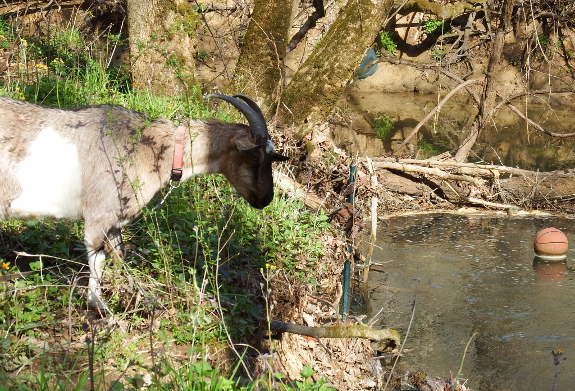
Eighteen months after
buying our first goats, we're gearing up to swap out half our herd.
Abigail is going to the butcher in three weeks to be replaced by one of
Artemesia's as-yet-unborn kids. So this seems like as good a time as any
to write one of those "if I'd know then what I know now" posts to help
anyone planning to follow along in our footsteps.
Question 1: Do I buy a goat with horns or without horns?
Answer then: Either is fine. Horns are natural and beautiful.
Answer now: Hornless.
Horned goats break apart your infrastructure and beat up on their
herdmates. Abigail is on the gentle side and has never seriously harmed
Artemesia, but it's better not to risk it.
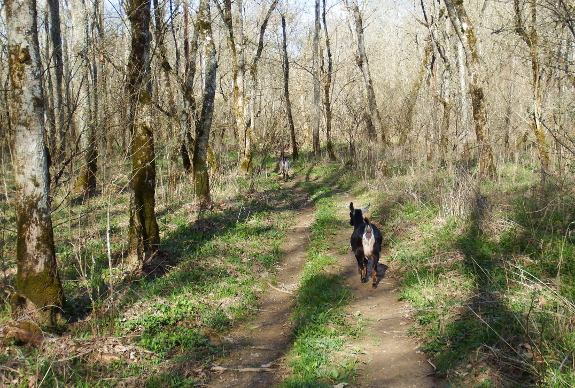
Question 2: Do I buy a cheap goat or pay the crazy prices breeders ask for a purebreed?
Answer then: I'll try one of each, but I'm not sold on purebreeds being worth the cash.
Answer now: My sample size is awfully small, but we definitely got what we paid for with each of our goats. Cheap Abigail is headstrong and makes trouble. Expensive Artemesia
is the most malleable animal I've ever worked with --- yes, including
Lucy. Maybe we got lucky, or maybe purebreeds really are the way to go.
We'll see how the sweetness carries through to the second generation.
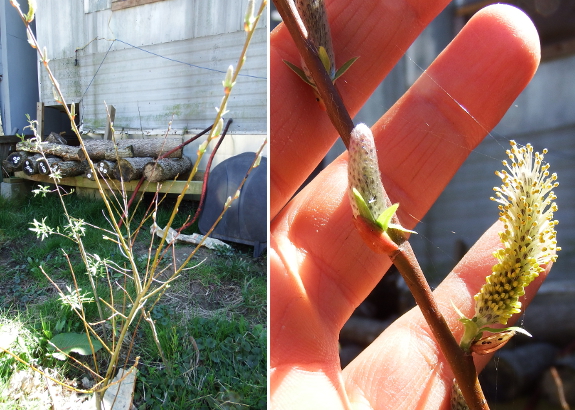
A year ago, I rooted these willow cuttings by the simple method of poking the dormant sticks into the ground in a damp spot. I semi-mulched them with a couple of sheets of cardboard...then I ignored them for the next twelve months.
A few of the cuttings
perished. The biggest danger to baby willows is apparently the
lawnmower, closely followed by dropping large mushroom logs on top of
their tender shoots. Goats nibbled on the leaves too, but that didn't
seem to be as much of a problem.
Now the best-looking
cuttings are blooming and all of the survivors are staring to leaf out. I
snipped all of the side branches so the bushes can start focusing on
upward growth. Soon we'll be in the training stage where I can start
weaving my living-tree sculpture!
I had to re-do one of the new
woodshed lattice walls today.
The problem was not enough
overlap. I was trying to spread it too thin.
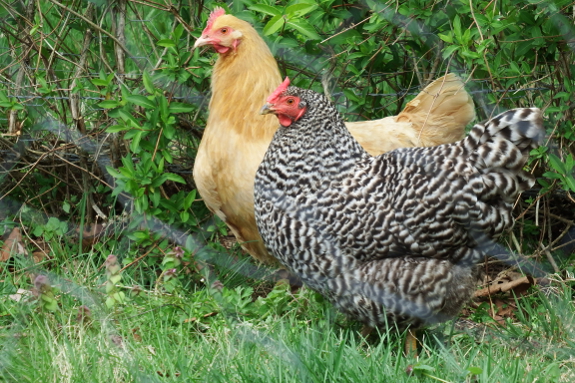
We put our main flock
back on pasture today. Even though they have the whole woods to roam
through in winter and early spring, the grass truly is greener on the pasture side of the fence.
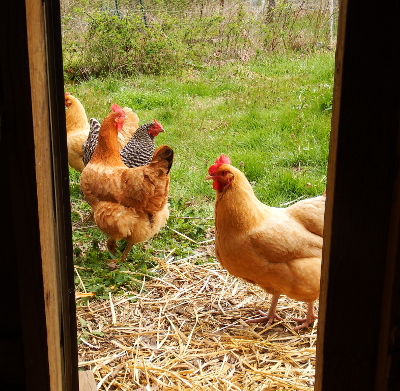 Why?
Good management. We kept poultry out of these areas while the plants
were just starting to break dormancy, so grass and clover had time to
get their feet under them before being pecked to death.
Why?
Good management. We kept poultry out of these areas while the plants
were just starting to break dormancy, so grass and clover had time to
get their feet under them before being pecked to death.
To maintain that healthy
state, we'll rotate our flock into a new pasture in a week and continue
through all four pastures before returning to this first location after
nearly a month of rest. With the exception of extreme summer droughts,
that should keep the flock happy and healthy all year.
Want the long version of this short explanation? My book Pasture Basics
walks you through setting up rotational pasture systems for your flock
that will keep your grass green and your chickens happy. Good luck!
 Did
you miss my introductory 99-cent offer when Personality Tests for Your
Soil first came out in January? Then you're in luck --- I've marked the
ebook down to 67% off for the next few days so you can nab a copy. Here
are the links:
Did
you miss my introductory 99-cent offer when Personality Tests for Your
Soil first came out in January? Then you're in luck --- I've marked the
ebook down to 67% off for the next few days so you can nab a copy. Here
are the links:
In other soil-book news, the print book
(which contains the entire, four-ebook series) got a new look last
month. I wasn't so sure about the brighter cover at first, but it's
really grown on me and now I think it's a perfect fit for the
easy-reading but sound-science tone of the text inside. Even more
exciting, Skyhorse outsourced a German version to Mobiwell Verlag, so
those of you who sprechen Deutsch will soon be able to snag a copy at
your local bookstore. I'm excited to be reaching more international
readers!
Already have a copy of
Personality Tests for Your Soil? Maybe you'd be willing to leave a
review or tell a friend about the sale. That social proof is enormously
valuable and your kind words make it possible for me to experiment and
share my results for free here on the blog as well as in my books.
Thanks in advance for anything you feel you can do!
We got 40 bales of straw this
morning for Spring and Summer garden mulching.
Walter runs the Punkin Patch Farm,
which is a nice field trip option if you are a school teacher in the
area looking for a wholesome farm to take your class to.

I keep telling Kayla she needs to become a travel agent. Every local attraction she hooks me up with is 100% fun and the William King Art Museum
was no exception. I'd been there before, but there was something
special about the company this time around. Mom, Kayla, baby D...plus
Bigfoot, who turned his head to greet us at the door.
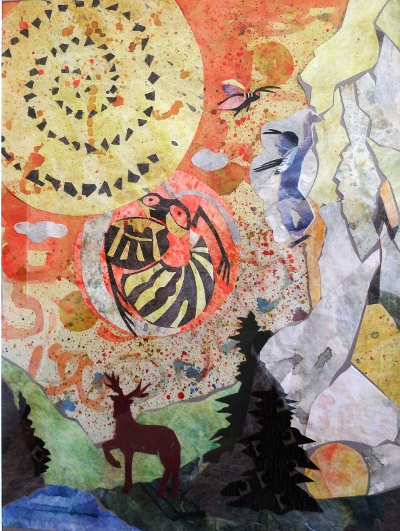 My favorite exhibit didn't really photograph well, unfortunately. Witches and Wild Things by Lillian Trettin
consists of stunningly intricate and magical prints and collages that
detail both real and imagined Native American/Appalachian folklore.
My favorite exhibit didn't really photograph well, unfortunately. Witches and Wild Things by Lillian Trettin
consists of stunningly intricate and magical prints and collages that
detail both real and imagined Native American/Appalachian folklore.
If you go (and I highly
recommend it), you'll want to walk through this series twice. First,
just look with your eyes --- the images are labeled only by number, so
you can use your own imagination to guess what each one portrays. Then
pick up the laminated key to learn what the artist intended each image
to represent. The one shown here is "How the Yellowjacket Came to Be."
(Yes, I really did make
my aged mother and a six-month-old baby go through the exhibit twice.
They're never going anywhere with me again.)
As one final side note
--- I asked at the desk before going in and they said I could take
photos. I hope the artists don't mind! My notes aren't perfect, but I'm
pretty sure the artists in the collage (clockwise from upper left) are:
???, Mark Cline (creator of Foamhenge), Susana Esrequis, and Delia Flores.
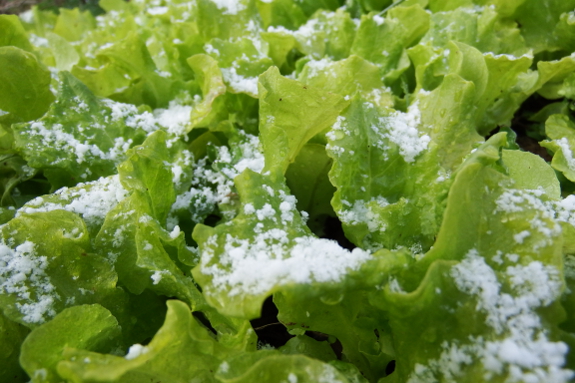
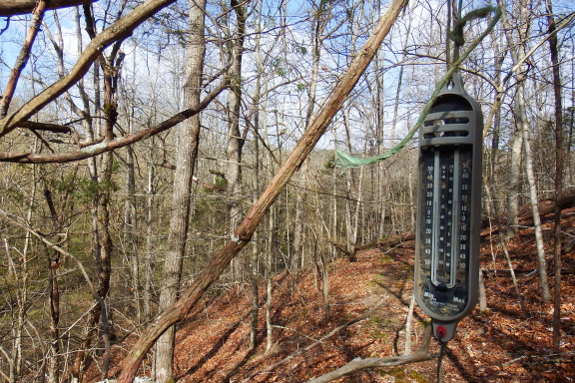
Photos don't lie. I've resorted to voodoo in an effort to get fruit-tree blossoms to bypass spring freezes.
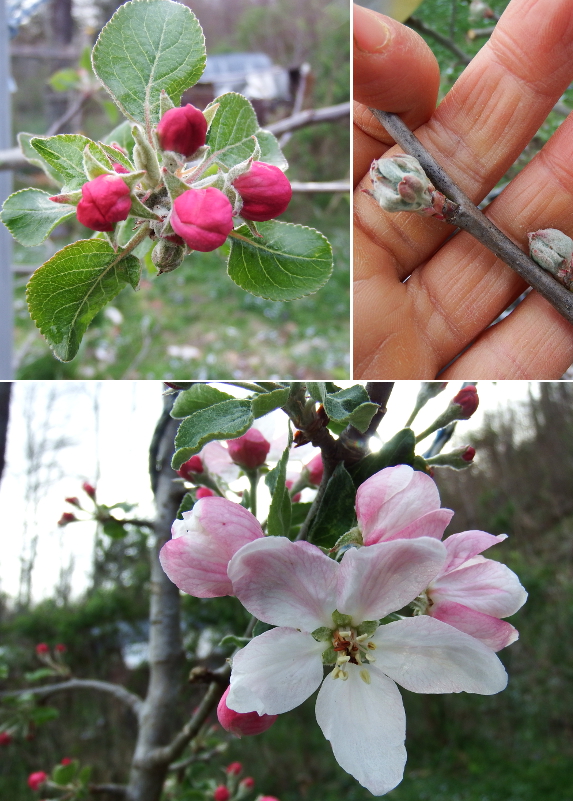
I don't even want to talk
about the hundreds of flowers on our now mature apple trees that are
currently being nipped by this extreme version of dogwood winter. Maybe
the few unopened buds like the ones shown in the upper right in this
photo collage will make it through...but I doubt it. Unfortunately, the
wind has just been too extreme to allow for much freeze protection and
the forecast doesn't look good.
So I'm focusing on what I
can change rather than on what I can't. The weather is beyond my ken,
but location I can handle. To that end, I set out max-min thermometers in two locations that I think have the potential to bypass late spring freezes, or at least to mitigate them a bit.
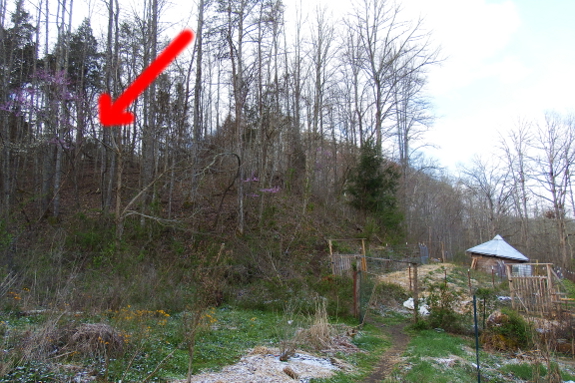
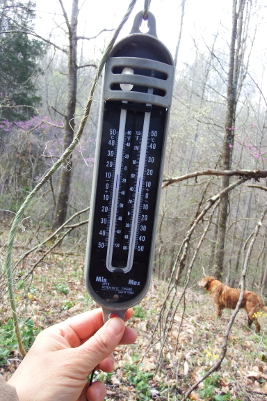 Option
one, shown above, would be my preference. This little knoll is just
above our core homestead, so access is easy (minus the hill climbing).
Old pines have been falling in this area for the last few years, so it
wouldn't be quite so heart-wrenching to take down the forest to make way
for fruit trees. And I can envision that mandatory deer fence butting
up against a goat pasture fence since I dream of someday using most of
this hillside to graze our herd.
Option
one, shown above, would be my preference. This little knoll is just
above our core homestead, so access is easy (minus the hill climbing).
Old pines have been falling in this area for the last few years, so it
wouldn't be quite so heart-wrenching to take down the forest to make way
for fruit trees. And I can envision that mandatory deer fence butting
up against a goat pasture fence since I dream of someday using most of
this hillside to graze our herd.
On the downside, this
knoll is even closer to the north-facing hillside that shades a large
portion of our core homestead than we are. While that location sounds
like it would slow down bud opening in the spring, in my experience
being close to a north-facing hillside just means permafreeze causes
less hardy fruit trees to perish in the dead of winter.
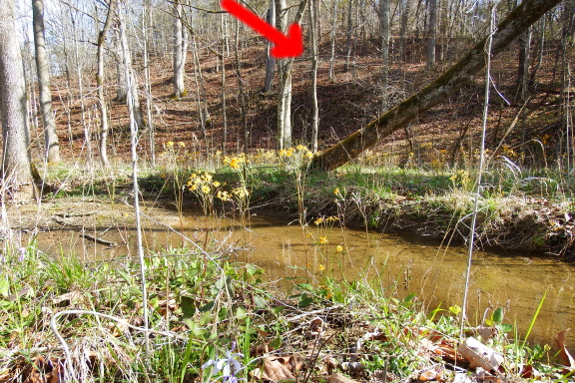
Option two is a little
further away from our core homestead, but is still an easy walk...across
the creek and up the hill. This hillside is south-facing and an old
logging road creates a 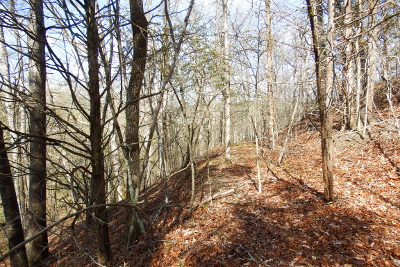 terrace that has been collecting leaves and building humus for decades.
terrace that has been collecting leaves and building humus for decades.
The main disadvantage of
this site is the big, beautiful trees on the south side of the logging
road. It would make me very sad to cut them down, so I'm hoping my
thermometer results will make the pine knoll out to be a better choice
than the logging road. Stay tuned for more data after I check the
thermometers and see if either, both, or neither flew through last
night's deep freeze unscathed.
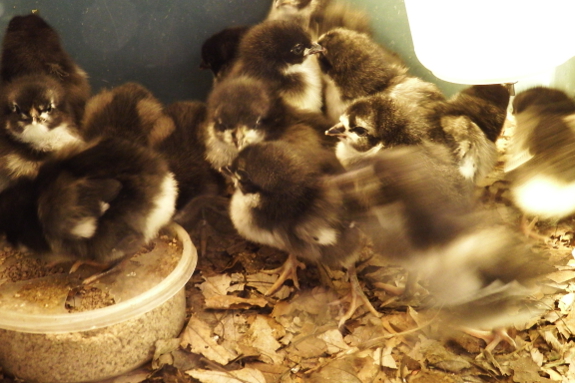
Life is simple when you're an australorp chick.
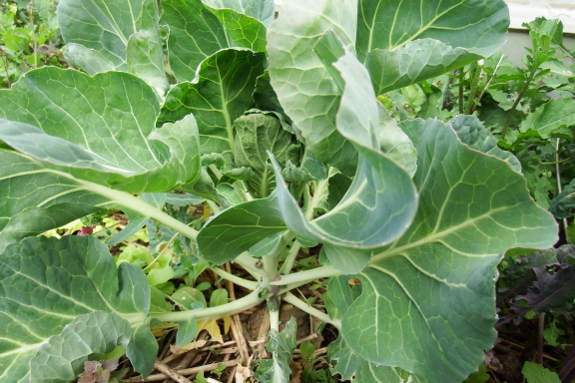
I stuck one of our baby
brussels sprouts in the cold frame last fall, figuring it would produce
for us later into the winter than the others. But instead, shade (I
assume) stunted the youngster and it sat with four or five true leaves
for months. I eventually wrote it off as a dud.
Imagine my surprise when
spring arrived...and the dud started to grow! It's now looking like we
might get May brussels sprouts from this little overwinterer --- the
plant seems not to have matured enough in the fall to prompt it to
flower this spring like you might have expected.
"Do that times ten next year," begged my brussels-sprout-loving husband.
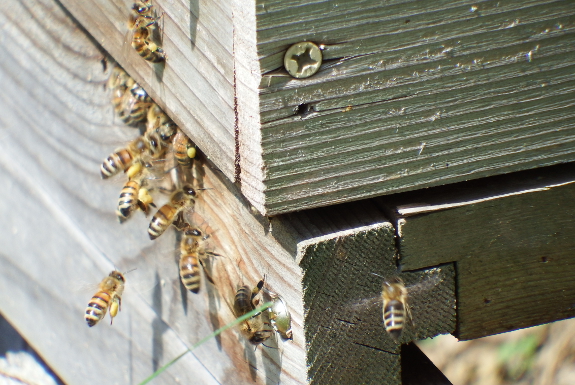
The bees in our Warre hive decided they didn't like their main entrance.
Perhaps the hole in our homemade entrance reducer was too small?
Now most of them go in and out through a crack near the back of the box.
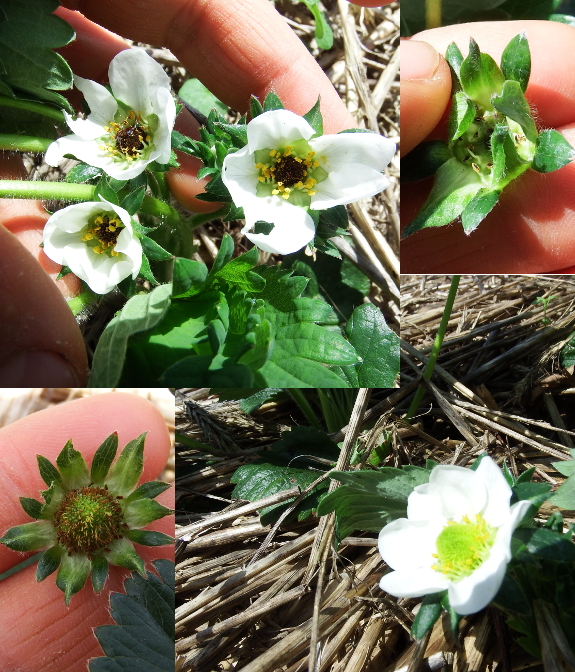
With the final hard
freeze of the 10-day forecast in our rear-view mirror, I uncovered
plants and assessed the damage. Bad news for early strawberries --- most
of the blooms that were partially opened were nipped despite my double covering.
Luckily, strawberries flower slowly over a few-week period, so the
current loss just means we won't get ultra-early berries and that our
overall crop will be a bit reduced. We'll have to assess whether Gallettas are worthwhile given that nippage once they fruit.
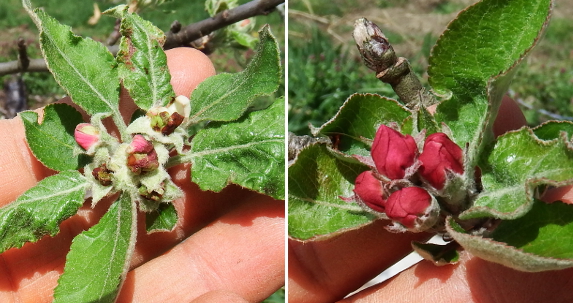
Similarly, the future
isn't looking good for our apple blooms...but there the fault is my own.
The image on the left shows a twig I left covered with a dogfood bag
for over a week. I'd hoped the plastic burlap would allow the twig to
breathe, but it's obvious the covering instead captured the sun and
caused overheating. In contrast, an uncovered flower cluster on the
right looks much prettier...although I suspect the ovaries inside will
be nipped and unable to make fruits due to the 21-degree night Saturday.
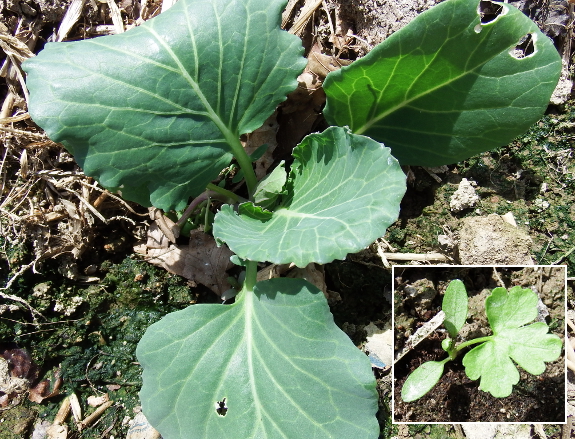
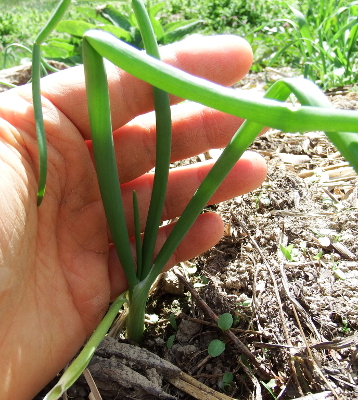 On the plus side, our spring vegetables came through nearly or entirely unscathed.
On the plus side, our spring vegetables came through nearly or entirely unscathed.
I'd left transplants under row covers ever since setting them out a couple of weeks ago,
so I got a very pleasant surprise when I removed the fabric and saw
huge cabbage plants, nearly as big broccoli, impressive onions, and
small but growing parsley.
I guess our indoor seed-starting revamp this spring is paying off, even
if late freezes are continuing to make tree fruits a gamble.
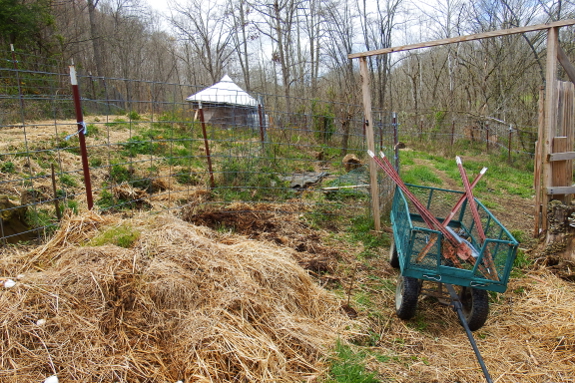
We dismantled our final tree alley this week in preparation for building our fourth goat pasture. Although the idea was good,
it matched up better with the animals I was used to pasturing when I
conceived it --- chickens. Goats require so much more grazing area that
it seems preferable to use our limited fencing supplies to enclose the
largest possible square footage rather than separating out zones to
protect woody perennials.
One more day of
fence-post pulling and I should be ready for the fun part --- putting
those cattle panels back up in a new arrangement!
Today's the day we moved our
new chicks to the outdoor brooder.
We ordered 17 but lost one
that showed up on constant chirp mode.
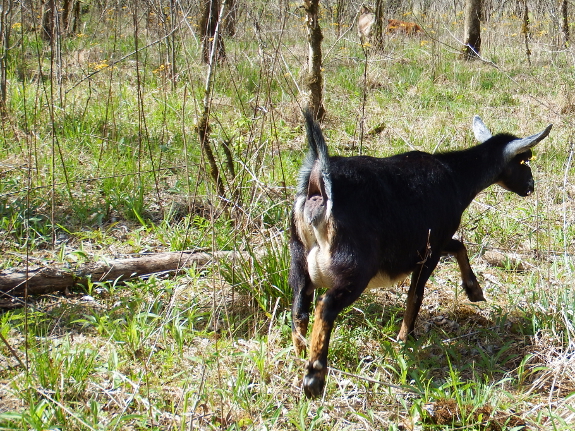
Unfortunately, that dose of Safe-Guard really knocked Artemesia's guts out of whack. As I mentioned in a previous post, the dewormer killed all of the threadworms...but
paved the way for an infestation of another parasite that my extension
agent IDed through email as the dreaded barberpole worm. Barberpole
worms are resistant to common over-the-counter dewormers, so my options
as I saw the parasites' numbers rise consisted of either contacting a
vet or seeking further options.
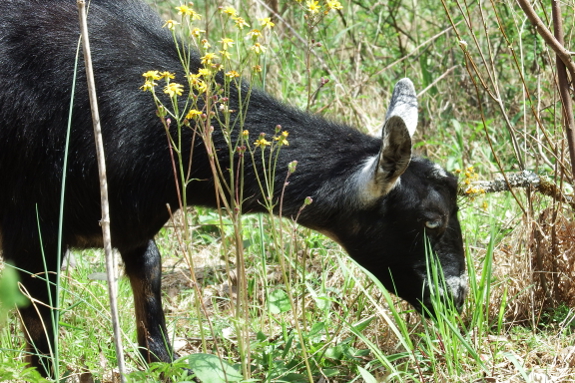
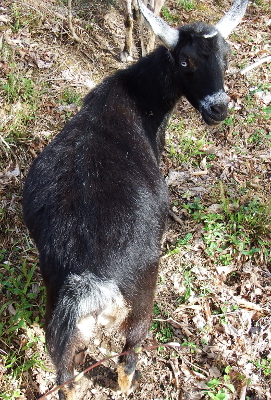 I
figured I'd first try seeking further options. Initial item on the
agenda: refresh the mineral and kelp feeders...again. Artemesia's belly
has gotten so round that it's tough for her to stick her neck over the
edge of the mineral feeders, which I only realized when she started
asking me to hand feed her kelp after her daily meals. (Yes, of course I
complied.) Once she was able to easily reach inside again, she started
scarfing the stuff like it was candy.
I
figured I'd first try seeking further options. Initial item on the
agenda: refresh the mineral and kelp feeders...again. Artemesia's belly
has gotten so round that it's tough for her to stick her neck over the
edge of the mineral feeders, which I only realized when she started
asking me to hand feed her kelp after her daily meals. (Yes, of course I
complied.) Once she was able to easily reach inside again, she started
scarfing the stuff like it was candy.
That should have clued me in about the need for option C, but I instead turned to Molly's Herbal Goat Dewormer (the safe-for-pregnancy version).
Artemesia scarfed her first dose down quite nicely mixed with molasses
and I soon started seeing a better look to her fur and eyelids. Of
course, I was doubling down on her minerals at the same time (and
haven't yet done a followup fecal analysis), so don't have a clear idea
what caused the effect and if the barberpole worms are indeed on the
decline.
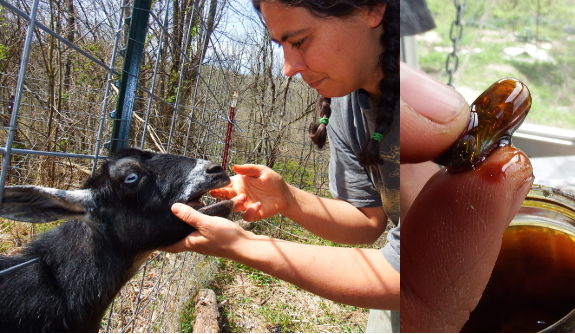
While waiting to catch a fresh poop sample, I also ordered some copper boluses (the 2 gram version
since Artemesia isn't quite big enough to get the full-size-goat
pills). I could write for hours about the pros and cons of boluses, but
here's the cliff notes version:
- Goats require lots of copper and boluses seem to be more effective than either kelp or mineral mixtures at getting that copper in their system.
- Goats low on copper tend to be high on parasites.
- But boluses scared me away initially because you're really supposed to shoot the pill down the goat's throat with a bolus gun. Yikes!
Further perusal of the
internet, though, suggested that as long as those little wires go down
the gullet without too much chewing, they seem to stay in the rumen just
where they're supposed to, gun or no gun. Unfortunately, my method of
dipping the pill in molasses only succeeded in turning our goat a little
sweeter as she licked off the goop and then spat out the bolus. After a
trip to the store, we'll move on to the internet's low-tech solution
--- marshmallows.
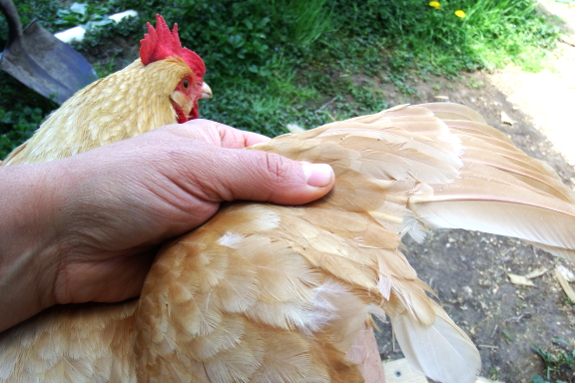
After some experimentation, Mark and I settled on Black Australorps
as the breed that best fits our farm. But then last spring I thought to
myself, "I'd really like to try a few more types of chickens that I've
never raised before." And so a mixed flock of Australorps, Buff
Orpingtons, Dominiques, Rhode Island Reds, and New Hampshire Reds showed
up on our farm.
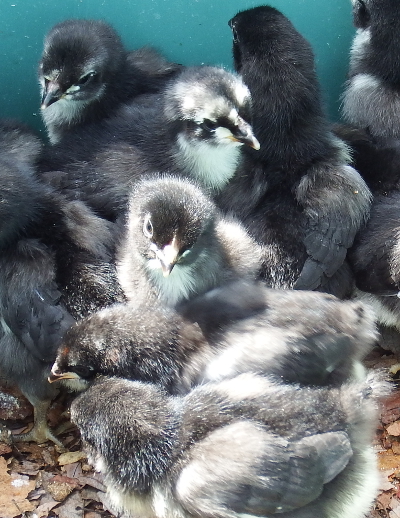 The
new breeds drive me nutty. Dominiques are so flighty...that they end up
in the garden. Buff Orpingtons are so people-oriented...that they end
up in the garden. Rhode Island Reds --- well, I'm not sure what they
are...but they end up in the GARDEN.
The
new breeds drive me nutty. Dominiques are so flighty...that they end up
in the garden. Buff Orpingtons are so people-oriented...that they end
up in the garden. Rhode Island Reds --- well, I'm not sure what they
are...but they end up in the GARDEN.
We put three bad hens in
the tractor last fall to deal with that issue, then I pushed everyone
else into the woods where they mostly behaved for the rest of the
winter. Now that I'm turning the flock back onto pasture, though, renegades are getting clipped. In case you're curious, the two renegades so far have been a Dominique and a Buff Orpington.
Which is the long version of why a box of layer chicks
came in the mail last week and the birds inside all looked exactly the
same. While it's probably unfair to the New Hampshires (who have yet to
cause any problems), I've decided to stick to the breed that has proven
itself multiple times over the past decade --- my favored Australorps.
Homesteading word to the wise: if it ain't broke, don't fix it.
We installed door number 4 in
the star
plate goat barn today.
An improvement on this
version is sinking a treated 2x4 in the ground on each side to help
stabilize the frame.
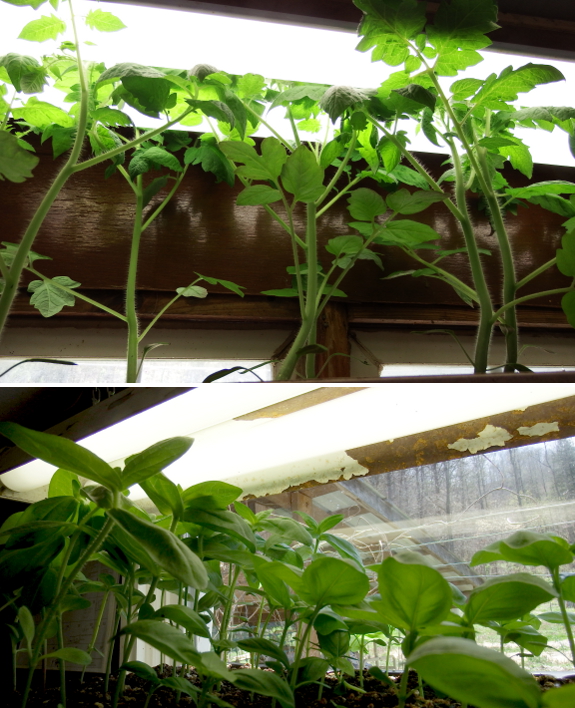
Adding lights to our
indoor seed-starting arrangement is like...well, the difference between
night and day. The seedling have been growing so fast that I'm thinking I
might need to change my seed-starting dates for next year.
After all, it's still a solid month until our frost-free dates and
zinnias are jumping out of their flats, tomatoes are trying to grow
through the lights on their highest setting, and one hardy pepper thinks
she might want to bloom. We'll either have a set of stunted, rootbound
plants in May or one of the earliest summer harvests our farm has yet
experienced.
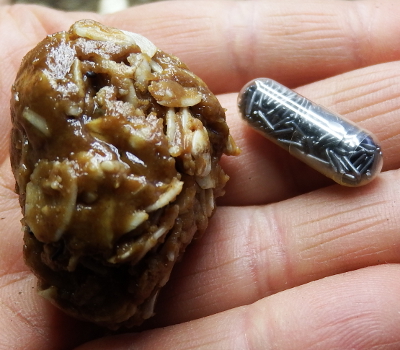 A huge thank-you to reader (Another) Julie who suggested turning one of my own favorite treats into a delivery method for our goat's bolus. (Okay, my recipe has cocoa in it and differs a bit in other areas too, but still....)
A huge thank-you to reader (Another) Julie who suggested turning one of my own favorite treats into a delivery method for our goat's bolus. (Okay, my recipe has cocoa in it and differs a bit in other areas too, but still....)
For the goat version, I
mixed peanut butter, molasses, and oats in the right proportions to get a
rollable ball. Then I split the bolus contents into three of these
"cookies," keeping the balls small enough to be goat-swallowable but big
enough to completely engulf the copper rods.
Artemesia gladly scarfed
down the first one, willingly ate the second after clearing her throat
with some alfalfa pellets, and will hopefully eat the last one today. Based on this website's goat x-rays, it sounds like the in-food feeding of copper rods should be just as effective as the scary bolus-gun method. Fingers crossed this will help nip our parasite problem in the bud!
Today's the day our batch
of Australorps gets their first chance to roam outside.
We leave the door open in the morning and it usually takes a day or two for one of them to
work up enough courage to see what's beyond their comfort zone.
Of course it's very important to remember to lock them back in at night.
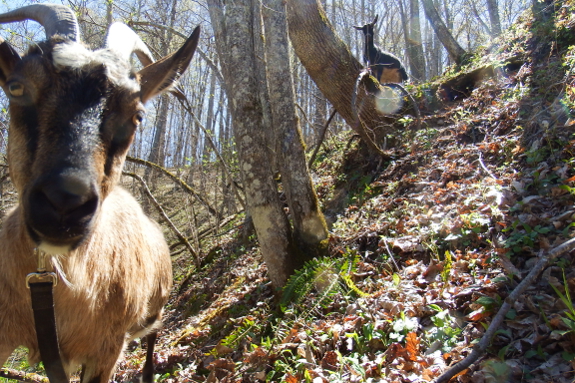
Mark detests bullies. As a
result, he was fully willing to take Abigail to the butcher --- or at
least to separate her into a different pasture --- weeks ago. But
Artemesia seemed to like being close to her herd mate, so I left the
pair together.
This weekend, though,
something shifted in Artemesia's behavior. Depending on whether she
takes after her father or her mother, she's due Thursday or a week from
Tuesday. And with kidding so imminent, our first freshener suddenly
stopped wanting to go back in the coop with Abigail after grazing and
feeding times. Instead, she kept trying to walk down one of the fallow
pastures toward the trailer as if maybe it would be okay to move in with
me instead.
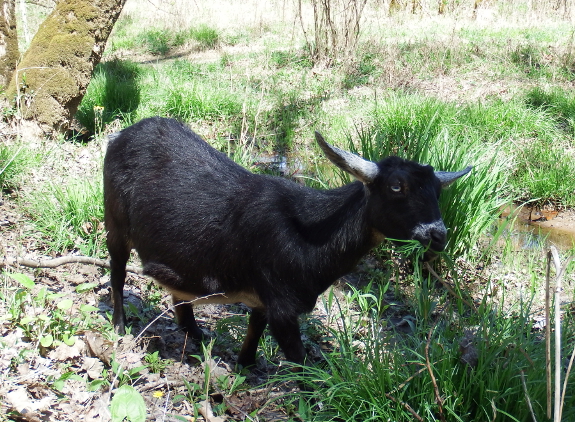
Unfortunately, Mark's not
quite soft enough for that to fly. But since Artemesia appears to
finally be sick of her bullying herd queen, we separated Abigail from
the mother-to-be.
If Artemesia continues to
prefer solitary confinement to life around a bully, we may even see if
we can step up our butcher appointment to this week instead of next. In
the meantime, we'll continue to coddle Artemesia as much as possible
while we wait for her kid(s) to arrive.
Cutting this tree adds some
of the finishing touches to our new goat pasture.
The goal is to have a fresh
new pasture for the upcoming kid delivery.
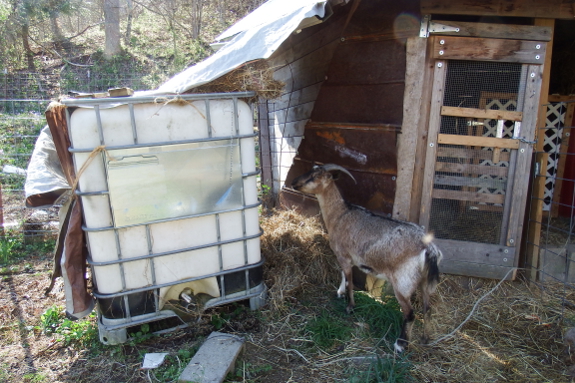
Before kicking Abigail out of the goat shed,
Mark took a couple of minutes to cobble together a basic, temporary
shelter for her. It's been awfully dry lately, so I think between 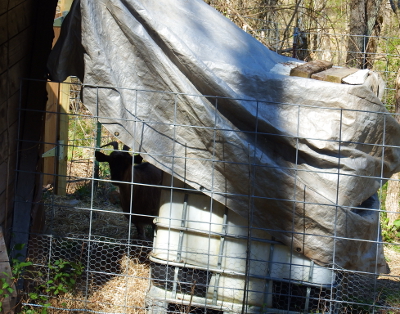 the tarp and the IBC tank our doe will be fine for the next week.
the tarp and the IBC tank our doe will be fine for the next week.
I was actually more
worried about how the ultra-social Artemesia would respond to being
neighbors instead of roommates with Abigail. To my surprise our first
freshener's reaction consisted of chewing her cud and taking advantage
of the peace and quiet to sleep in the next morning. Maybe Mark's gut
reaction to separate them weeks ago would have been the right decision
after all.
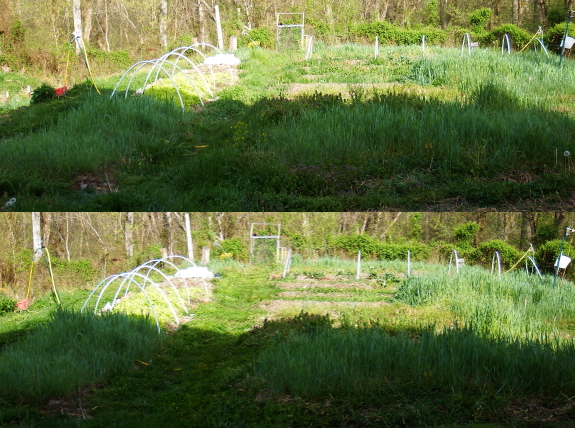
I've watched neighbors mow for the last two weeks, but didn't particularly think our "lawn" needed to be cut until now. But there's nothing like a
preparatory pass of the lawn mower through the aisles to make cleaning
up a garden area seem much more feasible.
Actually, I left
the grass to continue growing on both ends of the mule garden so I could
tether the goats there for company while I weed. Good thing no one
except you can see how I cherish our weeds rather than cutting them
down.
We got our latest goat gate
at Tractor Supply for 90 dollars.
Installation was smooth once we got our hinge holes drilled straight
and true.
I think the increased
longevity will be worth the extra money.
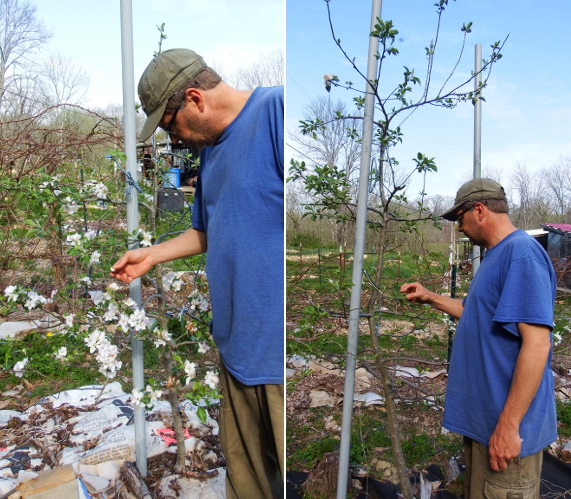
I thought those of you
making a tree-planting decision might get a kick out of this visual of
two apple trees of the same variety planted on the same day and starting
at the same maturity level.
On the left, we have a
dwarf tree (Bud 9 rootstock). The dwarf is shorter than Mark but is
absolutely coated with flowers. On the downside, nearly half of the
nearby dwarf trees perished during their 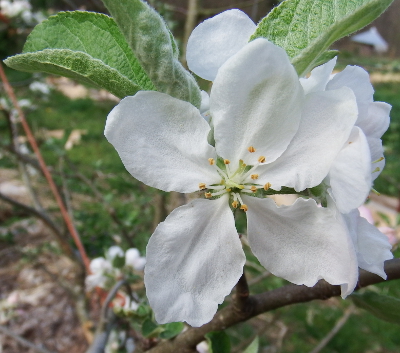 first two years of life --- they are much less hardy while getting established despite my careful weeding and mulching of the high-density row.
first two years of life --- they are much less hardy while getting established despite my careful weeding and mulching of the high-density row.
On the right, we have a
semi-dwarf tree (MM111 rootstock) that has been trained in the same
manner as the dwarf. The semidwarf is so tall I've already started it on
a size-restriction campaign (cutting off the central leader).
In terms of fruiting, this second tree created its first small flower
cluster this year, which you may or may not be able to see in the upper
left corner of the photo.
In case you're curious
about whether all of these beautiful blooms are going to turn into
fruit, I'd originally thought that our recent hard freeze did them in.
But a few of the later-opening flowers appear unnipped (based on the
color at the center of the bloom), so I'm keeping my fingers crossed but
trying not to get my hopes up. I'd love to be able to show you a photo
of the dwarf trees dripping with fruit in a few more months!
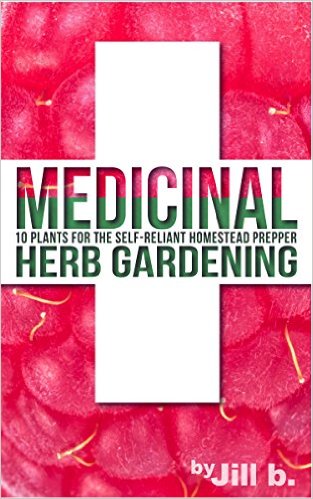 From homemade pepper spray to herbal remedies and compost teas, Jill Bong's Medicinal Herb Gardening has it all.
From homemade pepper spray to herbal remedies and compost teas, Jill Bong's Medicinal Herb Gardening has it all.
I particularly enjoyed
the way Jill focused in on ten high-quality plants rather than trying to
include every potential medicinal species known to man. I often get
lost in guides to edible and medicinal species because I don't know
which ones are worth trying and which ones are just maybe worthy of
using in a survival situation. Jill cuts through the vast array of
information to focus on a double handful of plants --- cayenne peppers,
comfrey, elderberry, garlic, marshmallow, peppermint, red raspberry,
sage, stinging nettle, and yarrow --- that will definitely make the cut.
Then she expands out to
growing, harvesting, and preparing those plants to keep your own
medicinal pantry alive throughout the year. Perfect for prepper,
homesteader, and interested layman alike, Jill's offering one free
paperback copy to a lucky reader. Just comment below with your favorite
medicinal herb then enter using the rafflecopter form below. Good luck!
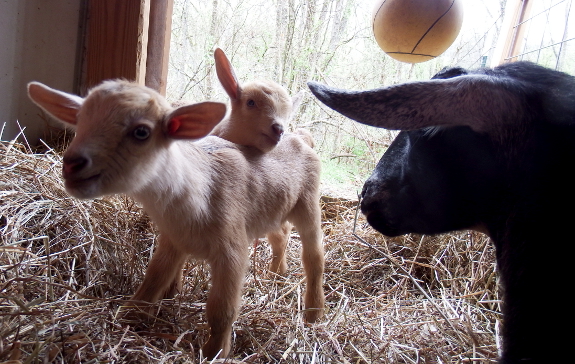
First a girl, then a boy.
Mother and kids are happy and healthy. Details to come.
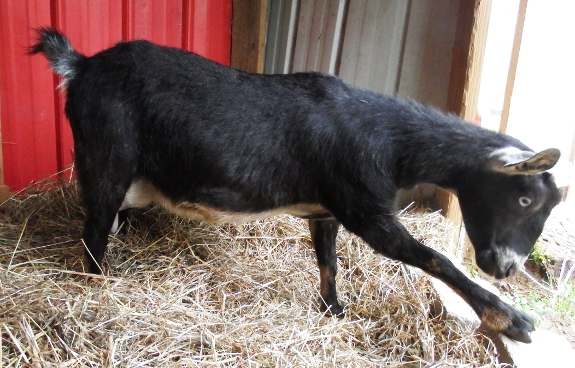
Monte's mom called up Wednesday to remind me that Artemesia could start popping out kids any day now. I was already a ball of 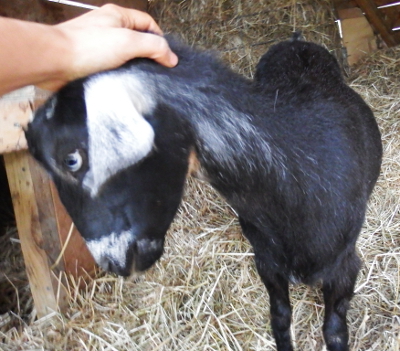 nerves, but had to be impressed by the personalized attention. Clearly Artie's boyfriend comes from good stock.
nerves, but had to be impressed by the personalized attention. Clearly Artie's boyfriend comes from good stock.
Since then, I've been
waking up way too early to check our first freshener's butt by
flashlight, but Artemesia is taking her late pregnancy in stride. Well,
except for begging for me to scratch her neck for a pretty much
indefinite amount of time every day.
Between the yawning and
the stretching and the mucous plug slowly oozing, signs of birth are
imminent. But after reading that average goat gestation period is
shortest for multiples, in the middle for male kids, and longest for
females, I'm rooting for Artemesia to hold out a little longer. I still
have my fingers crossed for a girl.
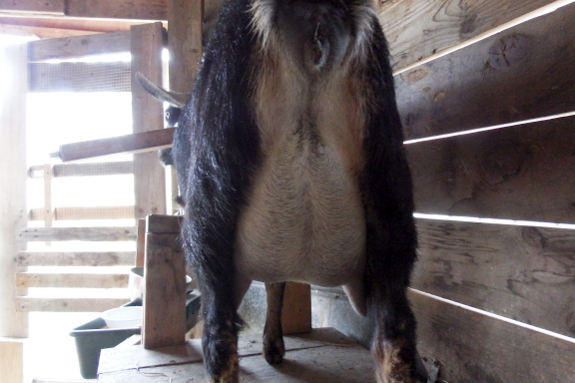
So I watch her tail positioning and the color of her mucous, but try to keep patient. It has to be soon, though. Our poor doe's udder is so humongous she can barely waddle and her teats are already about twice as big as Abigail's were at their peak. My hands are definitely breathing a sigh of relief. (What, your hands can't breathe?)
Artemesia likes to have her kids on the milking stand for easy protection.
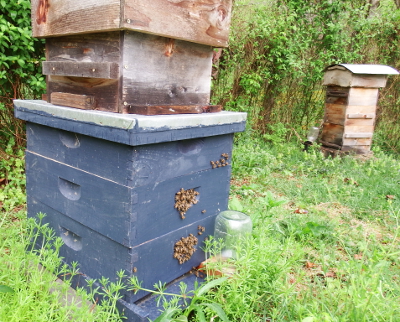 I'll bet you thought today's post was going to be about goats, didn't you? After checking on Artemesia Friday morning
and finding the kidding signs ominous but not necessarily imminent, I
decided to fill my day with small chores that could be easily
interrupted by trips to the goat barn. "Maybe I'll start by pruning that
grape vine I've been putting off since March," I said to myself.
I'll bet you thought today's post was going to be about goats, didn't you? After checking on Artemesia Friday morning
and finding the kidding signs ominous but not necessarily imminent, I
decided to fill my day with small chores that could be easily
interrupted by trips to the goat barn. "Maybe I'll start by pruning that
grape vine I've been putting off since March," I said to myself.
Heading over to the vine with clippers in hand, I was surprised to notice bees hanging out on the outside of one of our hives.
If it had been a hot afternoon, that could have been cooling behavior.
But the morning was chilly and drizzly. Uh oh --- looked like in all of
my goat obsession recently, I'd allowed the hive to swarm.
But this time, the swarm
was neither gone nor on a branch fifty feet above my head. Instead,
they'd settled on the U-post onto which Mark had attached a trellis wire
to train the young grape --- yes, the precise plant I'd come out to
prune.
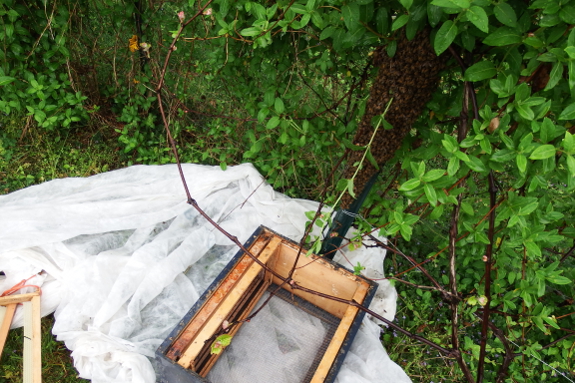
Mark was in town filming a
student project, so I called my beekeeping mentor instead. Frankie's
primary role in this project was calming me down --- I was pretty
jittery between my pre-dawn goat-barn visit and thinking through trying
to catch a swarm on my lonesome. But my mentor also gave me good advice
--- don't forget to put a sheet underneath the new hive (I used row
cover fabric) and shake the post rather than trying to brush the bees
into the hive.
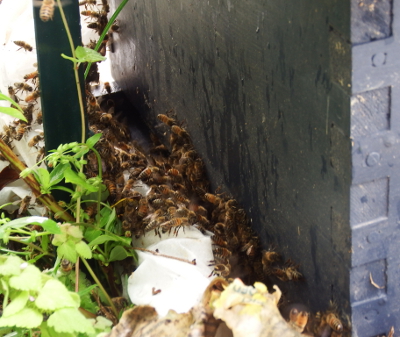 Thump, thump! The
mass of bees fell (mostly) into the deep Langstroth box exactly as
planned. But when I looked more closely, I realized the ones outside
weren't crawling in the way they should have if the queen was inside the
box. And when I braved the honeysuckle to look at the indented side of
the U-post, I saw that a considerable amount of the cluster was still
hidden in that cavity.
Thump, thump! The
mass of bees fell (mostly) into the deep Langstroth box exactly as
planned. But when I looked more closely, I realized the ones outside
weren't crawling in the way they should have if the queen was inside the
box. And when I braved the honeysuckle to look at the indented side of
the U-post, I saw that a considerable amount of the cluster was still
hidden in that cavity.
So I thumped again,
gnawed on my fingernails, called my beekeeping mentor...and was ecstatic
when a trip to the hive half an hour later found the box humming with
life and nearly every bee inside. (Yes, I'd inserted the frames and put
on the lid earlier.) Success!
Or so I thought. After
watching Artemesia deliver two healthy kids (more on that in tomorrow's
post) and spending a few hours cleaning the twins up and making sure
they could nurse, I went back to check on the bees. The box was empty,
my swarm fled. Yet again, I'd lost our hive's propagule to the wilds.
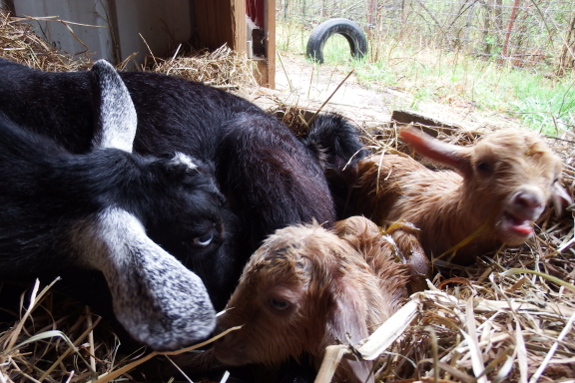
What would I do
differently next time? First, I would have listened to my beekeeping
mentor and my gut and checked out that hive earlier in the week. But all
I could think about was goats and gardens, so the bees once again ended
up on the back burner.
Second, once I saw that
the new hive contained most of my swarm, I think I might have blocked
off the entrance for a day. Surely that would have helped them decide
the box was home.
Third, if it hadn't been
raining, it might have helpted to take a comb of brood out of the mother
hive and insert it into the swarm box. After all, they say bees won't
leave brood.
All of that said, two bouncing goatlings are quite a consolation prize. And one of these days, I'll catch...and keep...a swarm.
Baby goats' first day out in the big world was brief due to a nervous Artemesia.
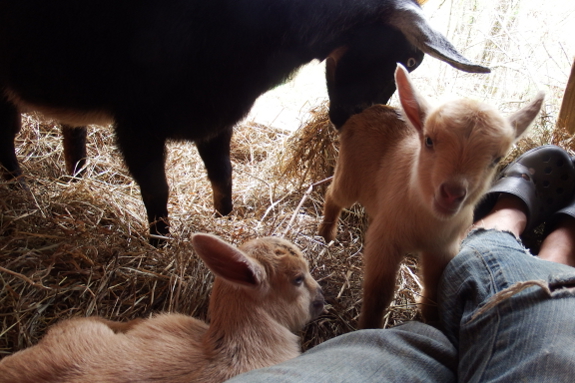
If you've been following along, you'll recall that I began Friday morning checking on my very pregnant goat before dawn. A second check at 8 am and a third check at 10 am showed her much the same. But after hiving a swarm of bees, the 11:30 am check presented a very different picture:
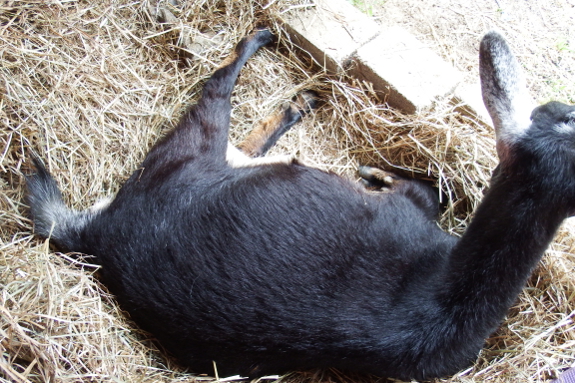
Some goats may lie like
this normally. But, to me, the visual was an obvious sign of labor.
Artemesia had made a little nest in the new hay I'd laid down the night
before, and her hind legs were stretched out rather than tucked
underneath. Then, as I watched, she experienced a minor contraction. The
time had come at last.
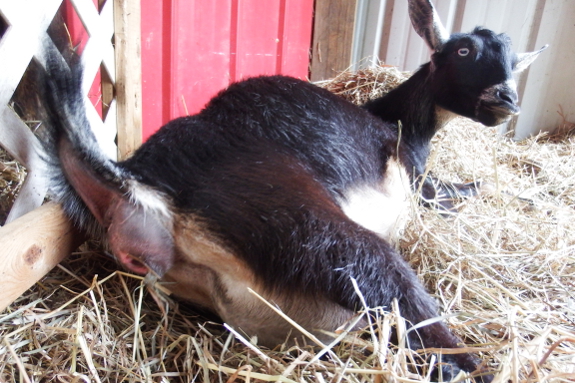
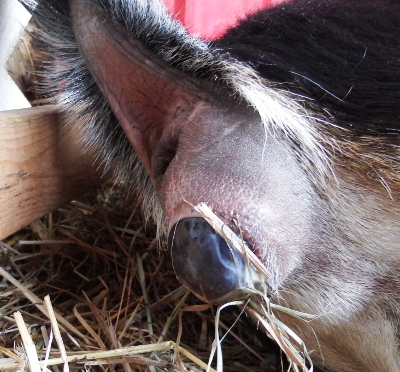 So
I rushed back to the trailer and grabbed the bare minimum birthing kit
--- two old towels, a watch, a notebook, and a bite of lunch for me. I'd
offered Artemesia a portion of Nutri-Drench
that morning mixed with molasses and oats just to be on the safe side
and she'd only eaten half of it, so I knew I had some emergency
sustenance on hand for the mother-to-be.
So
I rushed back to the trailer and grabbed the bare minimum birthing kit
--- two old towels, a watch, a notebook, and a bite of lunch for me. I'd
offered Artemesia a portion of Nutri-Drench
that morning mixed with molasses and oats just to be on the safe side
and she'd only eaten half of it, so I knew I had some emergency
sustenance on hand for the mother-to-be.
When I returned to the
goat barn, it felt like Artemesia had been waiting for me. Her
contractions came closer and closer together as she began to push out
what looked like a scary big, dark thing...but which was actually a
liquid-filled membrane.
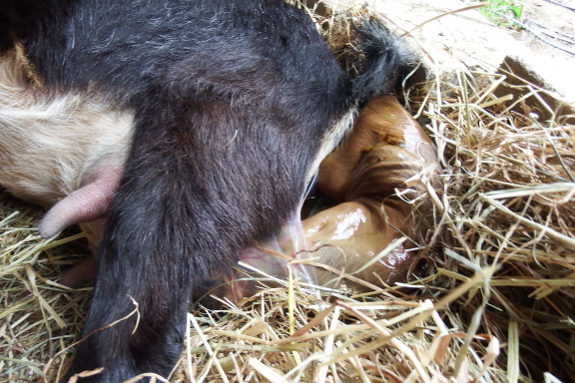
The beginning part of her
labor was a bit slow, giving me plenty of time to second-guess
everything up to and including getting my favorite goat knocked up in
the first place. But she didn't appear to be in pain (although she was
obviously working).
Then, right at noon,
Artemesia began pushing in earnest. She cried a couple of times...and
out popped kid number one. I didn't know at the time, but this was a
baby girl.
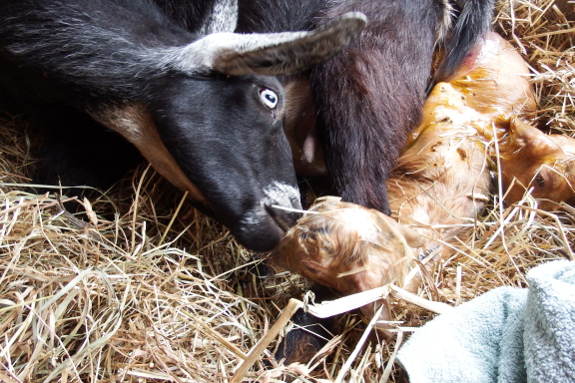
I only had time to pull
the doeling's nose out of the sac of liquid (which hadn't entirely
burst) before Artemesia was licking her...and pushing out kid number two
(a boy) at the same time.
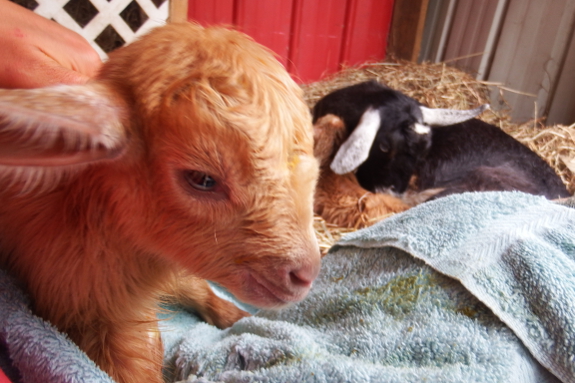
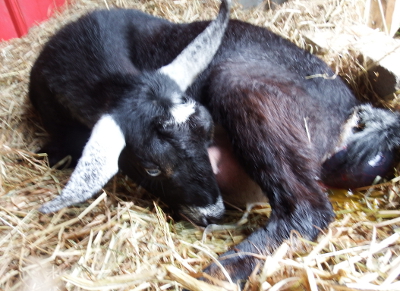 Artemesia
proved to be the world's best mother immediately. She licked and licked
and licked at those kids, not even taking the time to stand up and get
the placenta the rest of the way out for quite a while. (It had mostly
passed and clung to her butt for about an hour anyway, so I guess there
was no hurry.)
Artemesia
proved to be the world's best mother immediately. She licked and licked
and licked at those kids, not even taking the time to stand up and get
the placenta the rest of the way out for quite a while. (It had mostly
passed and clung to her butt for about an hour anyway, so I guess there
was no hurry.)
I helped her out by
drying the kid she wasn't currently working on, then swapping them
around so each got a bit of towel action and a bit of motherly TLC. That's when I took the time to peer at the 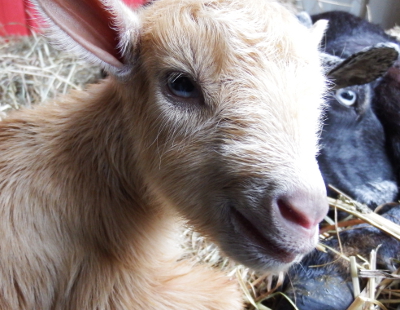 kids'
privates and discover that the first kid --- a little paler in color
with a subtle dark streak down the middle of her back --- was a girl.
The redder kid who turned out to be a bit more adventurous was a boy.
Maybe you can tell that the boy is the one in my lap in the photo above
while the girl is shown to the left?
kids'
privates and discover that the first kid --- a little paler in color
with a subtle dark streak down the middle of her back --- was a girl.
The redder kid who turned out to be a bit more adventurous was a boy.
Maybe you can tell that the boy is the one in my lap in the photo above
while the girl is shown to the left?
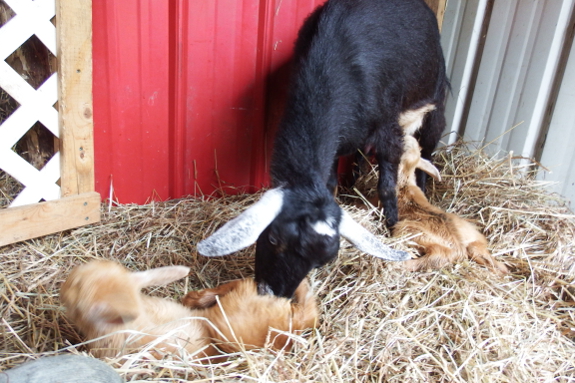
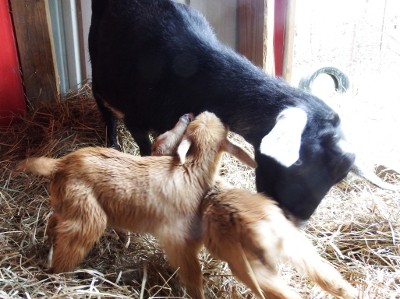 Finally, Artemesia decided she could lick just as well standing up as lying down, and I began pushing kids toward her teats. Unlike Abigail,
Artemesia wasn't averse to the idea of having her teats tugged on, but
she was so intent on licking that she didn't give the kids much
opportunity to drink. The youngsters also had a little trouble figuring
out how to push those tremendous teats into their tiny mouths.
Finally, Artemesia decided she could lick just as well standing up as lying down, and I began pushing kids toward her teats. Unlike Abigail,
Artemesia wasn't averse to the idea of having her teats tugged on, but
she was so intent on licking that she didn't give the kids much
opportunity to drink. The youngsters also had a little trouble figuring
out how to push those tremendous teats into their tiny mouths.
But after a short while,
I'd seen milk go down both kids' gullets. I breathed a big sigh of
relief --- my job was pretty much done.
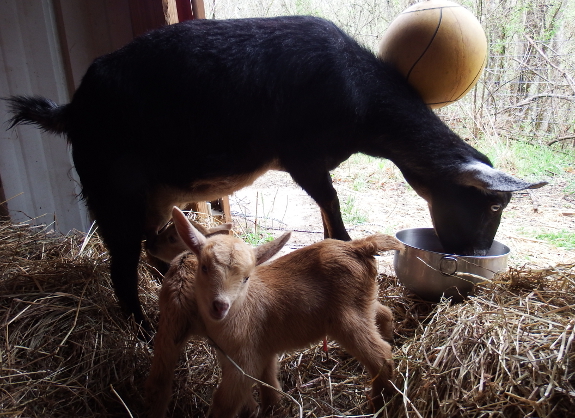
Actually, I planned to go
home and rest for a while. I'd woken at 5:30 a.m. worried about my herd
and now I felt like I'd been through the wringer even though Artemesia
was the one who did all the work. Plus, my hands were covered with goop
and I wanted to bring the new mother some molasses water to round out
the Nutri-Drench, alfalfa pellets, and hay she'd immediately started
glomming down once the kids were licked dry.
But my darling doe didn't
want me to go. She'd barely made a peep during the entire birth
episode, but as soon as I headed to the door she began to cry. "Don't
leave me!" (Yes, her sentence was entirely understandable even if she
didn't use words.)
I plugged my ears and
left anyway, though, and Artemesia figured it was worth it when I
returned five minutes later with that after-birth pick-me-up. And,
speaking of after-birth, the placenta had fallen away from her rear end
while I was gone, allowing me to scoop it out to Lucy...who'd been
waiting patiently in the wings the entire time.
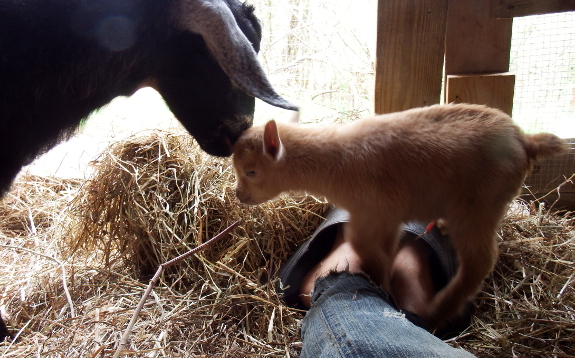
I sat with our new family
for about another hour while everyone slowly got to know each other and
then finally succumbed to exhaustion.
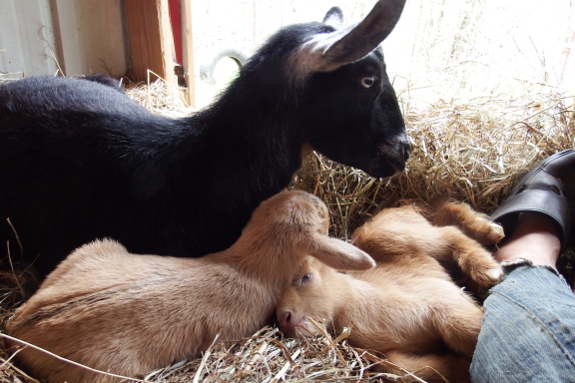
And once the cuddle pile
was fully formed, Artemesia let me leave without crying. She and her
twins were ready for a good long nap.
We attached some panel pieces to close in a gap to finish the new goat pasture.
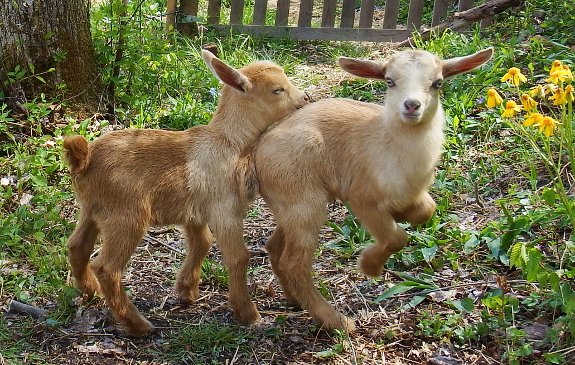
The problem with taking three posts to tell you about Friday is that I now have three days worth of goat excitement to share with you in one post. Let's see if I can be succinct....
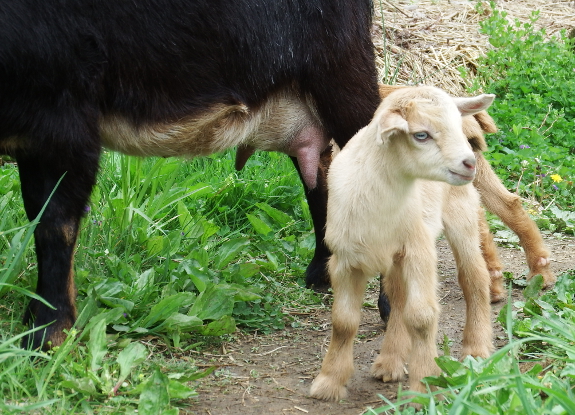
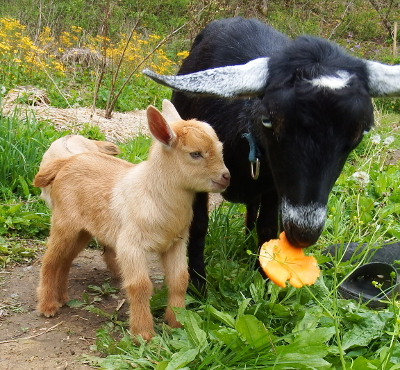 Reader question 1: Do the kids look like you thought they would?
The buckling (left) looks almost identical to his father and just like I
expected. He does have a tiny bit of white frosting on his ears and
maybe a couple of moon spots --- it's hard to tell because he's already
so pale. The doeling (top) is a bit paler and has a hint of a dark line
down the middle of her back.
Reader question 1: Do the kids look like you thought they would?
The buckling (left) looks almost identical to his father and just like I
expected. He does have a tiny bit of white frosting on his ears and
maybe a couple of moon spots --- it's hard to tell because he's already
so pale. The doeling (top) is a bit paler and has a hint of a dark line
down the middle of her back.
Reader questions 2 and 3: What are you going to name them? Are you going to eat the buckling?
The girl got the name Aurora when she was in the womb and it stuck. The
boy might be dinner...or the farmer who sells us our straw might want
the buckling to replace his current herd sire. Until we know for sure
about the little boy's future, we're keeping him nameless.
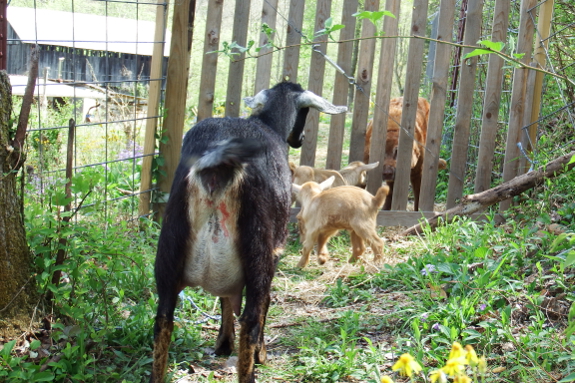
Now moving on to my own observations....
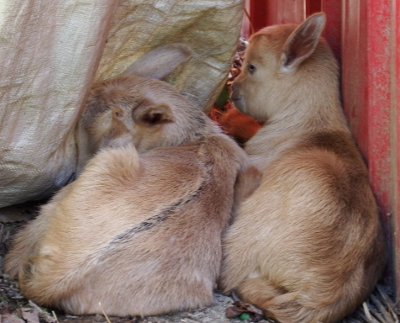 Artemesia
is the world's most protective goat mother, and she actually takes it
almost too far. Even though Lucy is extremely sweet, Artie is afraid to
let the kids get close to our canine companion. Instead, she stashes the
twins in a hidden spot like the one shown here (or, previously, on the milking stand)
before she goes out to graze. I'm slowly working on making Artemesia
feel more able to bring the little ones with her so she'll eat more
non-hay.
Artemesia
is the world's most protective goat mother, and she actually takes it
almost too far. Even though Lucy is extremely sweet, Artie is afraid to
let the kids get close to our canine companion. Instead, she stashes the
twins in a hidden spot like the one shown here (or, previously, on the milking stand)
before she goes out to graze. I'm slowly working on making Artemesia
feel more able to bring the little ones with her so she'll eat more
non-hay.
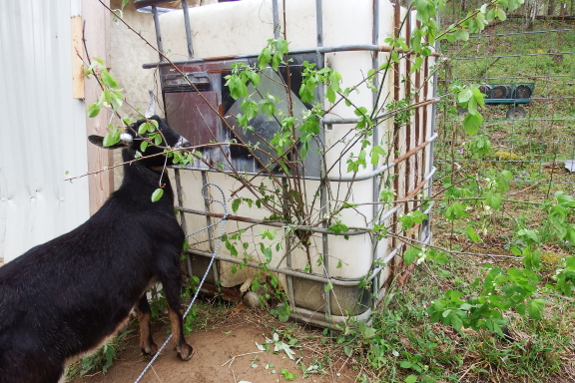
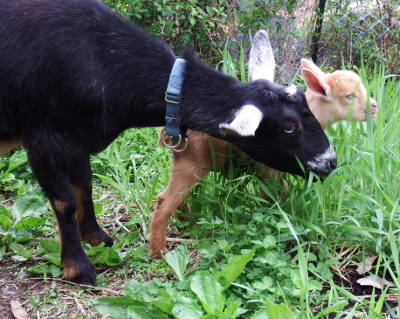 In
the meantime, I'm stuck bringing the fresh portion of dinner to her. To
that end, I'm spoiling Artemesia with her very favorite types of tree
branches, which I attach to the side of an IBC tank for easy leaf
picking, and with armloads of freshly cut rye stems. On that diet, she
seems to be bouncing back from her pregnancy very fast.
In
the meantime, I'm stuck bringing the fresh portion of dinner to her. To
that end, I'm spoiling Artemesia with her very favorite types of tree
branches, which I attach to the side of an IBC tank for easy leaf
picking, and with armloads of freshly cut rye stems. On that diet, she
seems to be bouncing back from her pregnancy very fast.
Now for a pop quiz ---
can you tell who's in the picture on the left? And which is the doeling
in the photo at the top of this post?
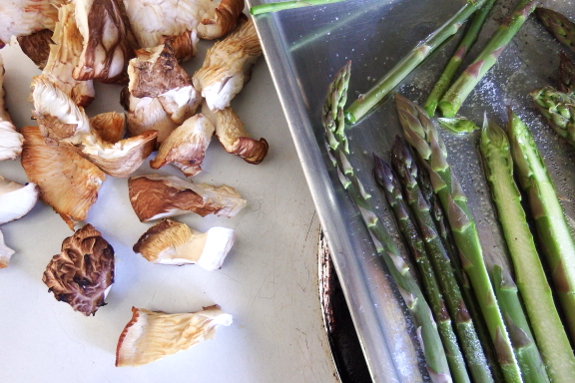
Are you sick and tired of
hearing about goats? I'm sure I'll stop posting cute kid photos
eventually. But in the meantime, here's a shot from elsewhere in the
homestead to round things out.
In the garden/kitchen,
we're eating asparagus almost every day, we got a small flush of
shiitakes after the recent rain, and we're gorging on lettuce. We're
also starting to mow and weed like crazy as we prepare for the biggest
planting push of the year around our frost-free date.
In other words --- business as usual at this beautiful transition season midway between spring and summer!
Our early tomato plants are
too big for their britches.
We decided to risk a killing
frost and put 6 of them in the ground today.
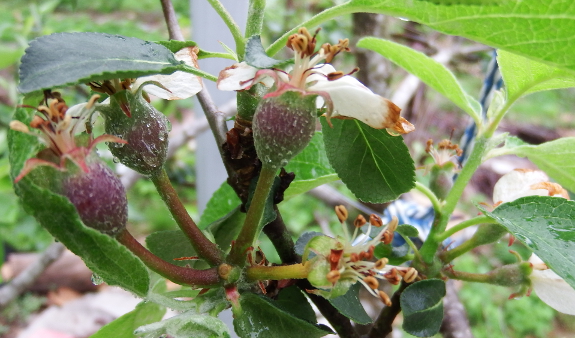
I'm trying really, really
hard not to get my hopes up about non-berry fruit this year...and
failing miserably. The deal is --- we still have 2.5 weeks until our
frost-free date, so anything could happen.
That said --- look! Baby
apples! This is the moment of truth, when old flowers drop off the trees
if they were damaged or went unpollinated. And, yes, the earliest
blooming variety lost all of its flowers and even the later bloomers
lost up to three quarters of their potential fruit due to a 21-degree night in early April.
Luckily, trees make many
more blooms than they could ever turn into apples. So, barring a late,
hard freeze, this might be a good fruit year after all.
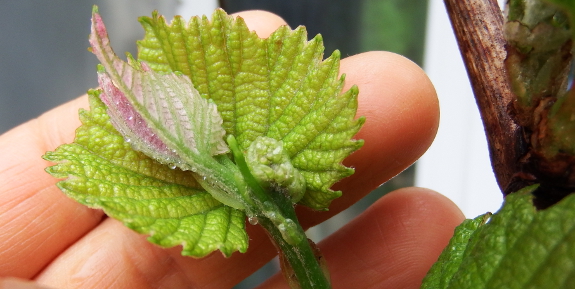
Our apple flowers seem to
pretty reliably turn into fruits if they're not nipped, but I'm having
to rein in my excitement a bit over our grape vines. The seedless
varieties we like to eat are very sensitive to fungal diseases, so I
planted a few vines right up against the sunniest sides of the trailer
a few years ago in hopes of creating a dry microclimate they can enjoy.
This is the first year I've seen bloom buds on those trailer-side
vines, so just maybe this year we'll actually get grapes. Fingers
crossed!
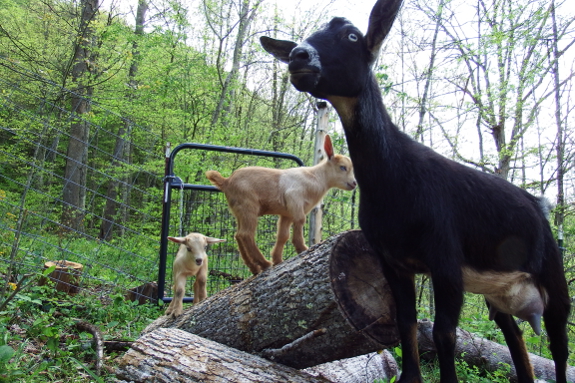
A week after the birth of her first kids, Artemesia has already given us nearly half a gallon of milk. Yes, I know you usually don't milk a goat so soon and the milk does
have a slightly bitter colostrum taste to it. But it was necessary, as
you can see by peering at our doe's udder in the photo above. Artemesia
is so productive that the kids are keeping fed by drinking nearly
entirely from her right teat, so it's up to me to keep the left half of
her udder drained every night.
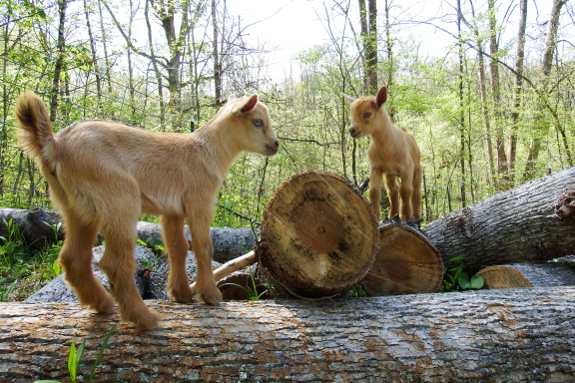
I would worry that the
kids aren't getting enough to eat, but their bellies are often full and
their energy levels are always high. Well, until they suddenly decide
it's time to nap, at which point the buckling settles down in my lap for
an extended petting session while Aurora snuggles up against her
mother.
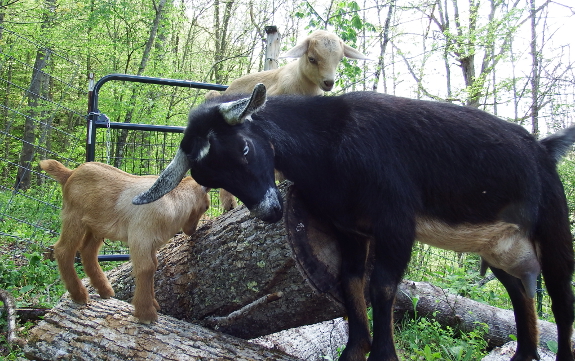
Artemesia is a joy to
milk compared to Abigail. Her huge teats allow me to use two fingers
instead of just one, and the milk squirts out about five times faster
than it did from our other goat.
Lest you think Artie is
invincible, though, I feel obliged to mention that she had a fit during
her first two milking sessions. Despite all of my pre-milking training,
when it came time for the rubber to hit the road our doe fought the
headlock, stamped her feet, and tried to sit down to hide her teats.
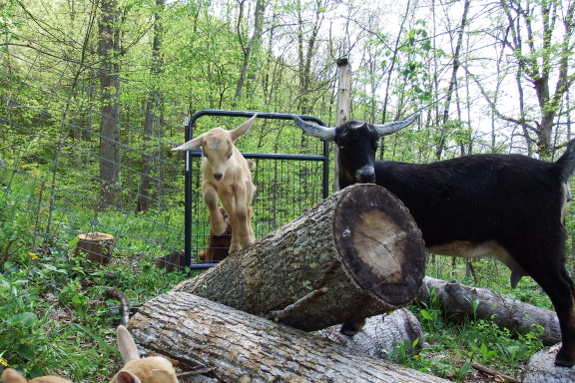
Then, two days later, it
was as if a switch flicked on. Or perhaps the change occurred because
the kids were getting old enough to jump on the milking stand and hang
out? Whatever the reason, the milk started to flow fast and furious and I
haven't had any trouble since.
(Well, yes, it is a constant necessity to watch out for flying goats. But such is life on our farm.)
The kids were jumping from
the milking stand into our
mineral feeders using them like a sand box.
Crossing my fingers that
moving them to another wall will put a stop to it.
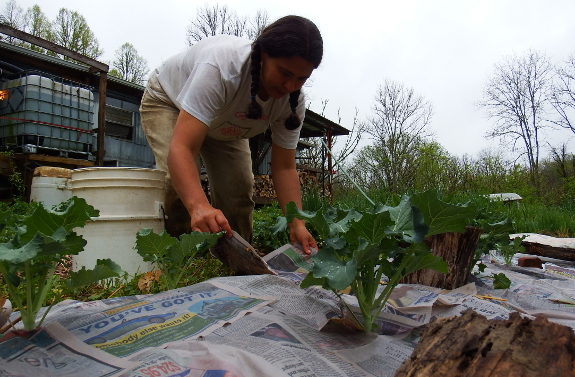
This year, I'm using all of the experiments that I summed up in Small-Scale No-Till Gardening Basics
to streamline our vegetable garden without ditching the biological
imperative to keep the soil happy. To that end, I'm applying wet
newspapers beneath straw wherever possible, which means all I have to do
is weed the small area right 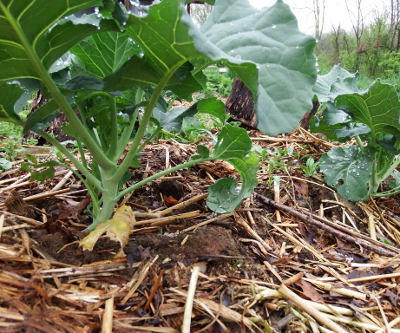 around the base of each plant rather than the whole bed before mulching.
around the base of each plant rather than the whole bed before mulching.
While the method doesn't
save any time in the short term, it does seem to reduce my need to weed
dramatically over the course of the year. That said, if you live in a
windy region and have relatively high raised beds, I'm not sure I'd
recommend the trick. Last month's newspaper mulches blew all over the
yard during what turned out to be the windiest month our farm has had in
a decade. Hopefully the current lull will extend for long enough to let
the paper meld to the soil below and the straw above, preventing my
hard work from blowing away.
The more Anna uses the Harvest
Sickle the more she likes
it.
It's the perfect tool for
cutting handfulls of rye to take to your goat.
Wear a glove because it's extremely sharp!
Want more in-depth information? Browse through our books.
Or explore more posts by date or by subject.
About us: Anna Hess and Mark Hamilton spent over a decade living self-sufficiently in the mountains of Virginia before moving north to start over from scratch in the foothills of Ohio. They've experimented with permaculture, no-till gardening, trailersteading, home-based microbusinesses and much more, writing about their adventures in both blogs and books.
